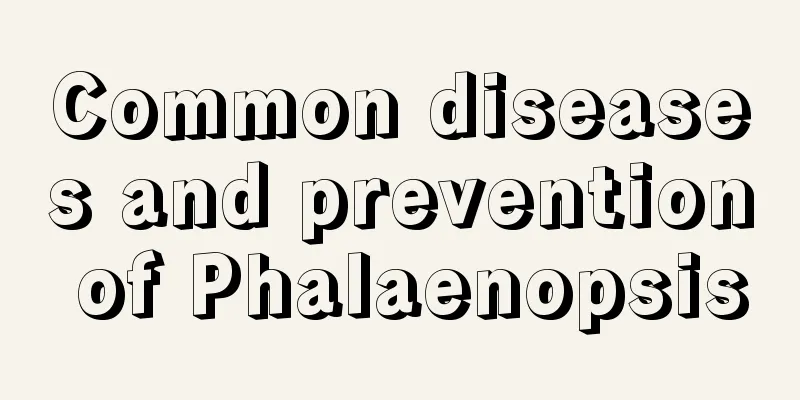Common diseases and prevention of Phalaenopsis

Common diseases and prevention methodsanthraxCausesThe warm and humid growing environment was not well ventilated. diseaseThe leaves are most susceptible to damage. At the beginning of the disease, small yellow spots will appear on the leaf tips and edges, gradually turning into round or irregular yellow-brown or dark-brown spots. In the later stage, the spots become patches with small black dots on them. PreventionFirst of all, there must be sufficient ventilation and light transmission, and then the management of water and fertilizer must be strengthened. The amount of nitrogen fertilizer applied should not be too much. The application of an appropriate amount of zinc fertilizer can increase the thickness of the leaves and improve disease resistance. To prevent this disease, you can spray equal amounts of Bordeaux mixture, 800 times of 65% mancozeb and 800 times of 75% thiophanate-methyl. Spray once every 7-10 days, and spray three times. If the disease has occurred, spray 800 times of anthracnose net, 500 times of 50% carbendazim and 1000 times of cypermethrin. Spray once every 7-10 days, and spray 2-3 times. Botrytis cinereaCausesIt is easy to breed in a humid environment with low temperature. diseaseFlowers are most vulnerable. At the beginning of the disease, water-like spots appear on the petals and sepals, and then slowly form large (dark) brown round patches. In severe cases, the entire flower will wither, greatly reducing the ornamental value of the Phalaenopsis. PreventionIt also requires good ventilation and light transmission, and a relatively dry growing environment should be maintained at this time. When diseased flowers appear, they should be removed immediately, otherwise the disease will be contagious. For prevention and control, spray 500-800 times diluted 65% mancozeb wettable powder, 1500 times diluted 50% procymidone wettable powder and 600 times diluted 3% methylene blue once every ten days, and 2-3 times will be enough. Soft RotCausesThe long-term impact of hot and humid weather. diseaseAt the beginning of the disease, transparent, water-soaked spots appear on the leaves. Later, the small spots will expand into brown spots, causing the leaves to rot and produce a foul odor. This disease spreads quickly and causes great harm. In severe cases, it can cause the base of the stem to rot and the plant to die within a short period of time. PreventionThe first step is to control the water content. Stopping water spraying can effectively cut off the transmission route of the disease. At the beginning of the disease, you can spray 1000 times diluted agricultural streptomycin with a concentration of 72%, 80 times diluted polyoxin with a concentration of 10%, 800 times diluted thiophanate-methyl wettable powder with a concentration of 50%, and 4000 times diluted phytosyltransferase for prevention and control. Spray once every ten days, and spray 2-3 times in a row. Brown spotCausesIt is easily affected by hot and humid seasons, and is particularly serious during typhoons or heavy rains. diseaseAt the beginning of the disease, the disease appears as light brown water-soaked spots, which gradually turn into brown or black (oval) irregular spots with a distinct yellow halo around the periphery. The disease is prone to worsening and is extremely harmful to the survival of seedlings. The leaves of old plants with severe disease will dry up or turn yellow, and then all fall off. PreventionThe prevention and control measures for this disease can refer to soft rot. Sclerotium rolfsiiCausesThe rainy season is the peak period for this disease, and it is also prone to occur in other hot and humid weather. diseaseAt the beginning of the disease, small yellow-brown water-like spots appear on the rhizomes, which then expand into brown spots. Under the influence of high humidity conditions, white silky hyphae and mouse-feces-like sclerotia will appear, causing the diseased plants to eventually die. PreventionFirst of all, ventilation measures should be taken to avoid too close spacing between potted flowers and between clusters of plants. Spray 1000 times of 50% concentration of Fordonin or 2000 times of 75% concentration of Metoprin for prevention and control, spray once a week for 3-5 weeks. |
<<: Common hyacinth pests and diseases control methods
>>: Symptoms and prevention of hyacinth mosaic disease
Recommend
The efficacy and function of galangal
1. Basic Information In order to prevent some fri...
What to do if the leaves of the potted rainbow arrowroot turn yellow
Reasons for yellowing leaves: illumination: It is...
Cucumber seedling raising time and method
As the weather gets warmer and the rainfall incre...
Can I prune flowers in summer?
1. Can it be trimmed? Flowers can be pruned in su...
When is the best time to plant spring corn?
Some friends may say that the earlier the spring ...
How to trim Asparagus cochinchinensis to look good
When is the best time to prune Asparagus cochinch...
The effects and contraindications of drinking monk fruit soaked in water
1. Efficacy 1. Improve immunity: It contains a va...
Can gardenia be transplanted in autumn? Can it survive if transplanted in autumn?
Can gardenia be transplanted in autumn? Gardenia ...
Cultivation methods and precautions of tiger orchid
1. Breeding methods 1. Loam: Slightly acidic loam...
Spring beans planting time and method
Spring beans planting time It is more appropriate...
How to plant red spider lily
1. Planting time The best time to plant red spide...
How to raise parrots
Parrots are a common pet bird, loved by everyone ...
8 ways to disinfect soil Simple and effective methods for soil disinfection and sterilization
Nursery plots and flower pots, etc., cultivate th...
How to deal with sunflowers in winter
1. Keep warm in time The temperature in winter is...
How to water succulent plants in summer?
Many people think that it is best not to buy succ...









